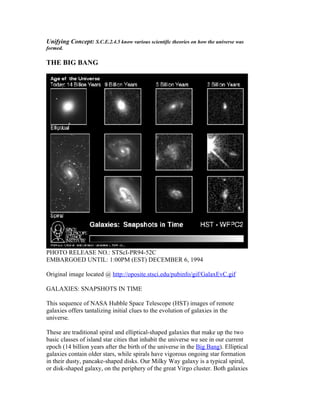
Unifying concept
- 1. Unifying Concept: S.C.E.2.4.5 know various scientific theories on how the universe was formed. THE BIG BANG PHOTO RELEASE NO.: STScI-PR94-52C EMBARGOED UNTIL: 1:00PM (EST) DECEMBER 6, 1994 Original image located @ http://oposite.stsci.edu/pubinfo/gif/GalaxEvC.gif GALAXIES: SNAPSHOTS IN TIME This sequence of NASA Hubble Space Telescope (HST) images of remote galaxies offers tantalizing initial clues to the evolution of galaxies in the universe. These are traditional spiral and elliptical-shaped galaxies that make up the two basic classes of island star cities that inhabit the universe we see in our current epoch (14 billion years after the birth of the universe in the Big Bang). Elliptical galaxies contain older stars, while spirals have vigorous ongoing star formation in their dusty, pancake-shaped disks. Our Milky Way galaxy is a typical spiral, or disk-shaped galaxy, on the periphery of the great Virgo cluster. Both galaxies
- 2. in this column are a few tens of millions of light-years away, and therefore represent our current stage of the universe s evolution. These galaxies existed in a rich cluster when the universe was approximately two-thirds its present age. Elliptical galaxies (top) appear fully evolved because they resemble today's descendants. By contrast, some spirals have a frothier appearance, with loosely shaped arms of young star formation. The spiral population appears more disrupted due to a variety of possible dynamical effects that result from dwelling in a dense cluster. Distinctive spiral structure appears more vague and disrupted in galaxies that existed when the universe was nearly one-third its present age. These objects do not have the symmetry of current day spirals and contain irregular lumps of starburst activity. However, even this far back toward the beginning of time, the elliptical galaxy (top) is still clearly recognizable. However, the distinction between ellipticals and spirals grows less certain with increasing distance. These extremely remote, primeval objects existed with the universe was nearly one-tenth its current age. The distinction between spiral and elliptical galaxies may well disappear at this early epoch. However, the object in the top frame has the light profile of a mature elliptical galaxy. This implies that ellipticals formed remarkably early in the universe while spiral galaxies took much longer to form. Credit: A. Dressler (Carnegie Institutions of Washington), M. Dickinson (STScI), D. Macchetto (ESA/STScI), M. Giavalisco (STScI), and NASA
